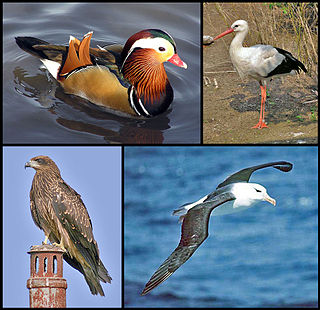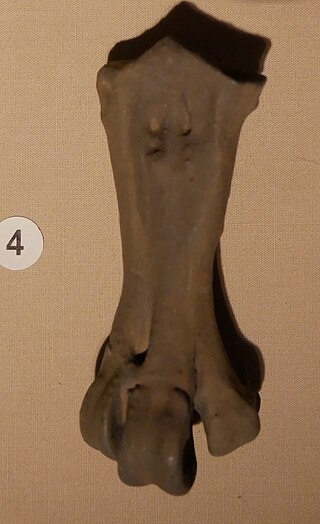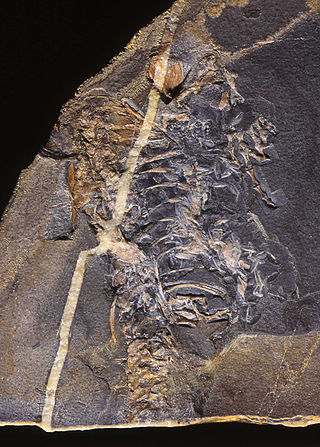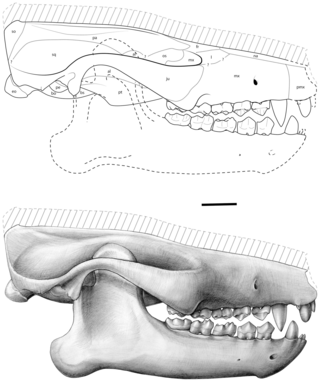
The Pelecaniformes are an order of medium-sized and large waterbirds found worldwide. As traditionally—but erroneously—defined, they encompass all birds that have feet with all four toes webbed. Hence, they were formerly also known by such names as totipalmates or steganopodes. Most have a bare throat patch, and the nostrils have evolved into dysfunctional slits, forcing them to breathe through their mouths. They also have a pectinate nail on their longest toe. This is shaped like a comb and is used to brush out and separate their feathers. They feed on fish, squid, or similar marine life. Nesting is colonial, but individual birds are monogamous. The young are altricial, hatching from the egg helpless and naked in most. They lack a brood patch.

Gastornis is an extinct genus of large, flightless birds that lived during the mid-Paleocene to mid-Eocene epochs of the Paleogene period. Fossils have been found in Europe, Asia and North America, with the North American specimens formerly assigned to the genus Diatryma.

Neognathae is an infraclass of birds, called neognaths, within the class Aves of the clade Archosauria. Neognathae includes the majority of living birds; the exceptions being the tinamous and the flightless ratites, which belong instead to the sister taxon Palaeognathae. There are nearly 10,000 living species of neognaths.

Waimanu is a genus of early penguin which lived during the Paleocene, soon after the Cretaceous–Paleogene extinction event, around 62–60 million years ago. It was about the size of an emperor penguin. It is one of the most important bird fossils for understanding the origin and evolution of birds because of the time period it comes from, and the position of penguins near the base of the bird family tree.

Presbyornis is an extinct genus of presbyornithid bird from North America during the Paleogene period, between the Late Paleocene and Early Eocene.
Hyposaurus is a genus of extinct marine dyrosaurid crocodyliform. Fossils have been found in Paleocene aged rocks of the Iullemmeden Basin in West Africa, Campanian–Maastrichtian Shendi Formation of Sudan and Maastrichtian through Danian strata in New Jersey, Alabama and South Carolina. Isolated teeth comparable to Hyposaurus have also been found in Thanetian strata of Virginia. It was related to Dyrosaurus. The priority of the species H. rogersii has been debated, however there is no sound basis for the recognition of more than one species from North America. The other North American species are therefore considered nomina vana.
Novacaesareala is a genus of prehistoric bird. It is known only from the fossil remains of a single partial wing of the species Novacaesareala hungerfordi. This was found in Hornerstown Formation deposits, probably from the latest Cretaceous (Maastrichtian) or Early Paleocene (Danian); it lived around 66-65 million years ago on the western shores of the Atlantic, where now is New Jersey.
The natural history of New Zealand began when the landmass Zealandia broke away from the supercontinent Gondwana in the Cretaceous period. Before this time, Zealandia shared its past with Australia and Antarctica. Since this separation, the New Zealand landscape has evolved in physical isolation, although much of its current biota has more recent connections with species on other landmasses. The exclusively natural history of the country ended in about 1300 AD, when humans first settled, and the country's environmental history began. The period from 1300 AD to today coincides with the extinction of many of New Zealand's unique species that had evolved there.

The Phaethontiformes are an order of birds. They contain one extant family, the tropicbirds (Phaethontidae), and one extinct family Prophaethontidae from the early Cenozoic. Several fossil genera have been described, with well-preserved fossils known as early as the Paleocene. The group's origins may lie even earlier if the enigmatic waterbird Novacaesareala from the latest Cretaceous or earliest Paleocene of New Jersey is considered a tropicbird.

Pachyrhizodus is an extinct genus of ray-finned fish that lived during the Cretaceous to Paleocene in what is now Europe, North America, South America, and Oceania. Many species are known, primarily from the Cretaceous of England and the midwestern United States.

Reptiles arose about 320 million years ago during the Carboniferous period. Reptiles, in the traditional sense of the term, are defined as animals that have scales or scutes, lay land-based hard-shelled eggs, and possess ectothermic metabolisms. So defined, the group is paraphyletic, excluding endothermic animals like birds that are descended from early traditionally-defined reptiles. A definition in accordance with phylogenetic nomenclature, which rejects paraphyletic groups, includes birds while excluding mammals and their synapsid ancestors. So defined, Reptilia is identical to Sauropsida.

Eurypygiformes is an order formed by the kagus, comprising two species in the family Rhynochetidae endemic to New Caledonia, and the sunbittern from the tropical regions of the Americas. Its closest relatives appear to be the tropicbirds of the tropical Atlantic, Indian, and Pacific oceans.

Ocepeia is an extinct genus of afrotherian mammal that lived in present-day Morocco during the middle Paleocene epoch, approximately 60 million years ago. First named and described in 2001, the type species is O. daouiensis from the Selandian stage of Morocco's Ouled Abdoun Basin. A second, larger species, O. grandis, is known from the Thanetian, a slightly younger stage in the same area. In life, the two species are estimated to have weighed about 3.5 kg (7.7 lb) and 10 kg (22 lb), respectively, and are believed to have been specialized leaf-eaters. The fossil skulls of Ocepeia are the oldest known afrotherian skulls, and the best-known of any Paleocene mammal in Africa.P
Australornis is a genus of extinct seabird discovered in New Zealand. It lived in the Paleocene epoch, 60.5 to 61.6 million years ago (Ma). The type species name originates from australis, Latin for "southern", and ornis, the Greek word for "bird", and lovei commemorates Leigh Love, an amateur paleontologist who discovered it.

Eurypygimorphae or Phaethontimorphae is a clade of birds that contains the orders Phaethontiformes (tropicbirds) and Eurypygiformes recovered by genome analysis. The relationship was first identified in 2013 based on their nuclear genes. Historically these birds were placed at different parts of the tree, with tropicbirds in Pelecaniformes and the kagu and sunbittern in Gruiformes. Some genetic analyses have placed the eurypygimorph taxa in the controversial and obsolete clade Metaves, with uncertain placement within that group. More recent molecular studies support their grouping together in Eurypygimorphae, which is usually recovered as the sister taxon to Aequornithes within Ardeae.

Messelasturidae is an extinct family of birds known from the Eocene of North America and Europe. Their morphology is a mosaic that in some aspects are very similar to modern hawks and falcons, but in others are more similar to parrots. Initially interpreted as stem-owls, more recent studies have suggested a closer relationship to parrots and passerines. Their ecology is enigmatic.

Kumimanu is an extinct genus of giant penguin, which lived around 60 to 56 million years ago. The type species is K. biceae, which arose after the extinction of the non-avian dinosaurs. Fossils were found in New Zealand, and the discovery was announced in December 2017. A second species, Kumimanu fordycei, was named in February 2023.

Fukuipteryx is an extinct genus of basal avialan dinosaurs found in Early Cretaceous deposits from Japan's Kitadani Formation. It contains one species, Fukuipteryx prima.
The Waipara Greensand is a geological rock unit found in Canterbury, New Zealand. It dates from just after the Cretaceous–Paleogene extinction event, the Selandian and Thanetian, around 62–58 million years ago in the Palaeocene. It is well known for its fossils, particularly for containing the oldest penguins (Sphenisciformes) and also containing shark and fish fossils.
Prophaethontidae is an extinct family of Early Paleogene phaethontiforms that include the genera Lithoptila and Prophaethon, as well as possibly Phaethusavis and Zhylgaia. The anatomy of the prophaethontids were more similar to those of members of the order Procellariiformes than to Phaethontidae, features including nostrils that are long and slit-like, with longer wings and legs. This suggests that prophaethontids were better at swimming and being more pelagic and surface-feeding than tropicbirds are today. Such features were suggested to link the phaethontiforms with the procellariiforms, but molecular studies do not support this and instead support a relationship between phaethontiforms and the order Eurypygiformes.














